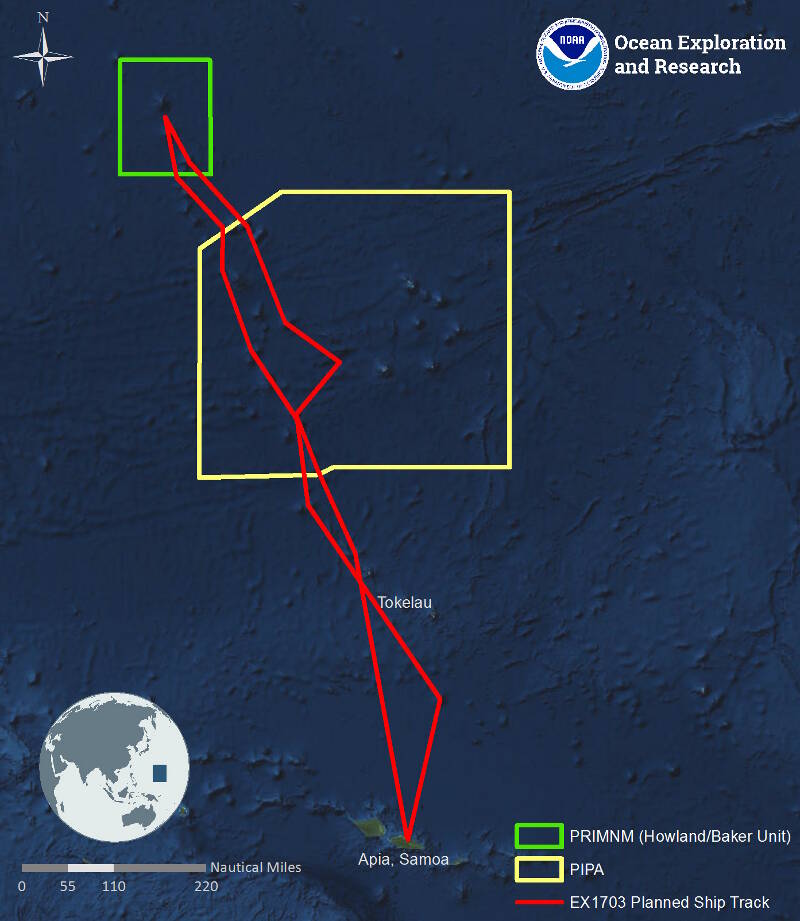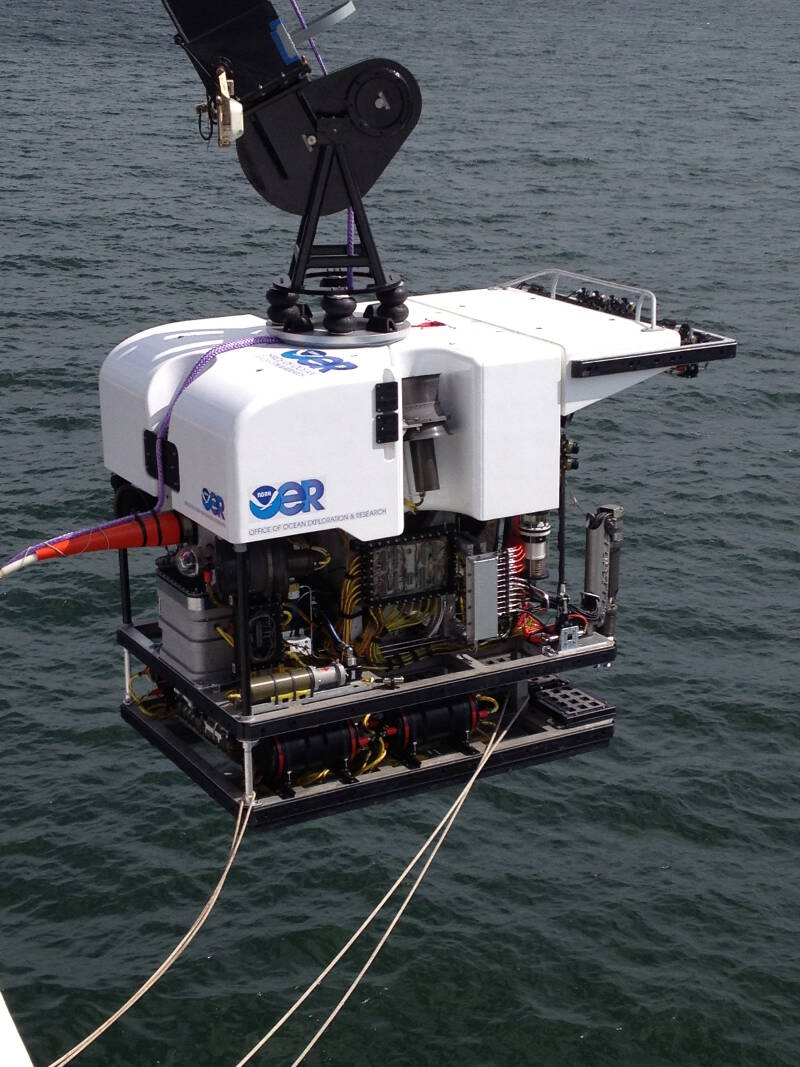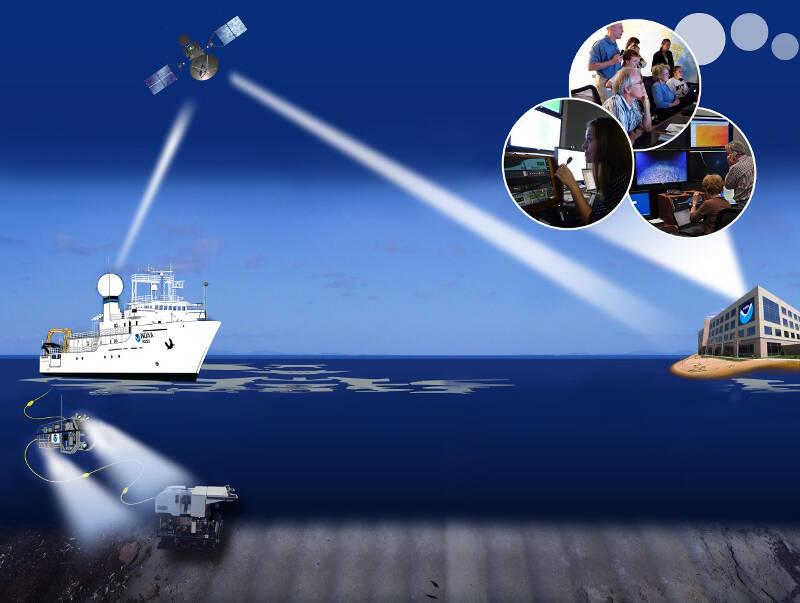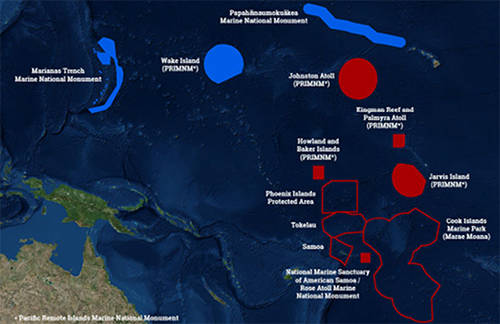
By
Brian Kennedy - Expedition Coordinator, NOAA Office of Ocean Exploration and Research
LTJG Nick Pawlenko - Assist. Expedition Coordinator, NOAA Office of Ocean Exploration and Research
Steve Auscavitch - Science Lead, Temple University
Amanda Demopoulos - Science Lead, United States Geological Survey

Map showing the general expedition operating area. The red line is the rough cruise track to and from the Pacific Remote Islands Marine National Monument (PRIMNM), now known as Pacific Islands Heritage Marine National Monument during the expedition. The yellow outline is the Phoenix Islands Protected Area. The green outline denotes the boundaries of the Howland and Baker Unit of the PRIMNM. Image courtesy of NOAA Office of Ocean Exploration and Research. Download larger version (jpg, 344 KB).
The expedition is part of the three-year Campaign to Address the Pacific monument Science, Technology, and Ocean NEeds (CAPSTONE), a foundational science initiative to collect deepwater baseline information to support science and management decisions in and around U.S. marine protected areas in the central and western Pacific. This serves as an opportunity for NOAA and the nation to highlight the uniqueness and importance of these national symbols of ocean conservation.

NOAA’s ROV Deep Discoverer (D2) will be used to acquire high-definition visual data of unknown and poorly known areas and collect limited samples during the expedition. Image courtesy of NOAA Office of Ocean Exploration and Research. Download larger version (jpg, 3.0 MB).
From March 7 – 29, 2017, NOAA and partners will conduct an ocean exploration expedition on NOAA Ship Okeanos Explorer to collect critical baseline information about unknown and poorly known deepwater areas in the Howland and Baker Unit of the Pacific Remote Islands Marine National Monument (PRIMNM) and the Phoenix Islands Protected Area (PIPA). Like previous expeditions, NOAA will work with the scientific and resource management communities to characterize these areas through telepresence-based exploration. Operations will use the ship’s deepwater mapping systems, NOAA’s dual-bodied 6,000-meter remotely operated vehicle (ROV) Deep Discoverer (D2) and Seirios, as well as a high-bandwidth satellite connection for real-time ship-to-shore communications.
The ship will conduct 24-hour operations consisting of daytime ROV dives and overnight mapping operations, including during transit. Operations will focus on priority ROV dive sites and mapping areas in and around PRIMNM and PIPA, as well as dives in New Zealand’s Territory of Tokelau, as the ship transits through to the cruise priority areas. ROV dive sites are expected to include deep-sea coral and sponge habitats, bottomfish habitats, and seamounts.
ROV dives will include high-resolution visual surveys and limited sampling. This expedition will help establish foundational information in the region to catalyze further exploration, research, and management activities. Live video of dives in the Howland and Baker Unit of PRIMNM and in PIPA can be viewed online in real time from March 8 – 27, 2017, typically from about 8 am to 5 pm WST (March 7 - March 26, from 2 pm to 11 pm EDT).
The Discovering the Deep: Exploring Remote Pacific MPAs expedition will address science themes and priority areas proposed by scientists and managers from NOAA and partners. Operations will complement previous and planned work in the area. NOAA priorities for the expedition include a combination of science, education, outreach, and open data objectives that will support management decisions at multiple levels:

NOAA Ship Okeanos Explorer uses telepresence technology to transmit data in real-time to a shore-based hub where the video is then transmitted to a number of Exploration Command Centers (ECCs) located around the country as well as to any Internet-enabled device. Access to the video combined with a suite of Internet-based collaboration tools allow scientists on shore to join the operation in real time and allows the general public to follow the expedition online. Image courtesy of the NOAA Office of Ocean Exploration and Research. Download larger version (jpg, 1.2 MB).
NOAA Ship Okeanos Explorer uses telepresence technology to transmit data in real time to a shore-based hub where the video is then transmitted to a number of Exploration Command Centers (ECCs) located around the country as well as to any Internet-enabled device. Access to the video, combined with a suite of Internet-based collaboration tools, allow scientists on shore to join the operation in real time and allows the general public to follow the expedition online.
The United States’ first and only federal vessel dedicated to exploration of our largely unknown ocean, NOAA Ship Okeanos Explorer, conducts operations in a unique way, using telepresence to engage the majority of the science team from shore. Via telepresence, real-time video and other oceanographic data are transmitted through satellite and high-speed Internet pathways to scientists around the country.
Scientists access the live feed by standing watches in ECCs, tuning in to the high-definition video via Internet-2, or watching the live video on standard Internet from their home institutions. Shore-based scientists interact with the ship through a teleconference line and Internet collaboration tools. Using these communication tools, scientists and students can contribute expertise and help guide the at-sea operations in real time, extending the reach of ocean exploration to more scientists and students than could possibly be accommodated onboard.

Map of U.S. marine protected areas in the central and western Pacific and operational areas for CAPSTONE. Image courtesy of the NOAA Office of Ocean Exploration and Research. Download image (jpg, 29 KB).
A number of ECCs will be online for the expedition, including viewing centers joining Okeanos Explorer operations for the first time. Formal ECCs include: the University of Hawaii at Manoa; NOAA's Inouye Regional Center in Hawaii; NOAA Headquarters in Maryland; Harbor Branch Oceanographic Institution in Florida; Inner Space Center at the University of Rhode Island; Stennis Space Center in Mississippi; University of New Hampshire; and Pacific Marine Environmental Laboratory in Washington and Oregon. UnderwaterWorld Guam will continue sharing the live video feeds with students and visitors, and in Independent Samoa, a viewing center may be set up at the National University of Samoa. Specialized viewing events will also be taking place at the University of the South Pacific in Suva, Fiji.
Scientists are also expected to participate from a number of other remote locations around the country and world. These scientists, and others on call if a discovery is made at sea, will contribute their expertise in real time to operations at sea.This expedition provides extensive opportunities for the public to connect to the mission. The live video feeds are available to anyone online, providing the public with a front row seat to exploration activities and discoveries as they are made.
Web content developed for this expedition includes background content; mission logs; daily updates; videos and images; and a live video feed. Education materials allow educators and students to engage their classrooms using products tied to the expedition, including standards-based lesson plans, background information, ocean career connections, links to previous Office of Ocean Exploration and Research-sponsored expeditions, and more.